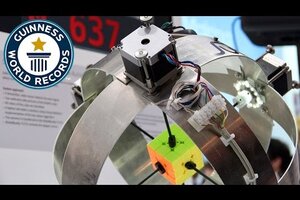Robot sets new Rubik’s Cube record
A Rubik's Cube-solving robot has set a new Guinness World Record for solving the iconic puzzle in just over half a second.

Robot breaks world record solving Rubik's cube in 0.637 seconds
Competition for a spot in the Guinness Book of World Records is fierce, particularly when those in the running are powered by ever-changing and advancing technology.
But if humans want to compete for the best time in solving a Rubik’s Cube, they’ll have to finish the classic puzzle in less than 0.637 seconds.
The Sub 1, a robot developed by German engineer Albert Beer of Infineon, first broke the Guinness World Record for solving a Rubik’s Cube in 0.887 seconds last January. But as of November, the latest model known as the Sub 1 Reloaded trimmed that time by around a quarter, finishing the puzzle in 0.637 seconds at the Electronica trade fair in Munich.
The time was first reported late last year and confirmed last week after record keepers examined the device to determine it adhered to all standards for competition.
Setting that pace required the robot to use six mechanical arms, unscrambling and sorting the colored squares into uniform, solid sides in just 21 moves. A video released by Guinness Friday shows the circular robot holding the unsolved cube in its center, a tiny robotic arm positioned on the middle square of each of the cube’s six sides.
Sub 1 reads two pictures of the scrambled patterns on the cube and quickly identifies the color on each square. It then uses a two-phase algorithm to find the solution and quickly maneuvers the pieces.
Engineers' first successful forays into Rubik’s Cube-solving robotics took off in the 1980s. In 1983, the best bot, named Cubot, could solve the puzzle in about two or three minutes.
While that’s still much faster than the average human’s work, the world’s best solvers could complete the puzzle in around 30 seconds at the time, a feat out of reach of those first prototypes.
Computers have advanced their abilities immensely, but so have humans. Kentucky teenager Lucas Etter set a new official record in 2015 for solving the cube by hand with a time of 4.904 seconds. A video shows another man solving the puzzle in around 4.74 seconds the following year.
Still, it’s hard to imagine people will ever surpass the robots' records, as 10 clumsy human fingers are no match for Sub 1’s six nimble metal arms.
While the stunt is impressive in its own right, engineers note that that the technology has broader implications, showing how effectively computers solve puzzles and problems.
Such developments could even play a role in bolstering automated driving technologies, showing how computers can act much more quickly than humans to react.
"We used this as a metaphor to show how digital systems are constructed," an Infineon spokesman, Gregor Rodehueser, told BBC last fall. "We want to show that problems can be solved much more efficiently using microelectronics.This is also the case when it comes to automated driving, where you have to have very low latencies and absolutely reliable and quick technologies."

